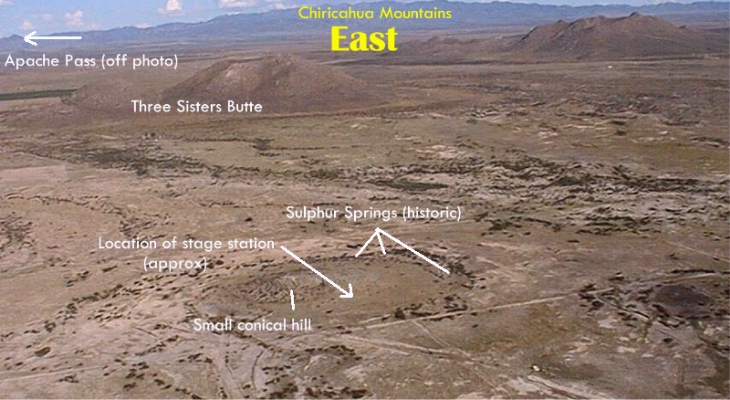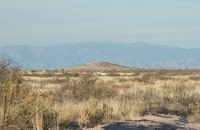Part
VI --- A Meeting of Minds -- cont.
Many years
in the future, Sladen would write, in a letter to Jeffords' friend Alice
Rollins Crane, the following:
|
"The whole adventure was unique in my army experience and, though I did
not regard it very seriously then, yet looked at through the long vista
of time that has since elapsed, it now looks a fool-hardy and uncalled-for
experiement, and had the result been a tragedy for us, the entire army
would have denounced it as a fools errand, and concluded that we were rightly
served." |
The experiment Sladen
refers to was about to reach its most dangerous aspect -- a fact that at
the time was not lost on anyone present. Ponce and Chie, who had
been vigilant from the start, were now perceptibly nervous, taking time
frequently to announce the group's intentions through various enigmatic
devices known only to the Indians.
Mounted on three
horses and a mule (for which General Howard had traded his horse back in
Tularosa), they made their way through the Peloncillo pass and then across
the San Simon Valley to the Dos Cabezas Mountains. Sladen, Jeffords,
Howard and Chie were mounted but Ponce, having left behind the horse Howard
had provided him, was afoot throughout much of the journey (Sladen wrote
later in his life that in truth Ponce had gambled the animal away the night
they left his camp). They camped at the foot of the Dos Cabezas,
at a spot known today as Indian Bread Rocks -- only about seven miles north
of Apache Pass and Fort Bowie.

PHOTO
BY GEORGE ROBERTSON
| Above
is a panoramic view of the east side of the Dos Cabezas Mountains.
Sulphur Springs Valley lay on the other side, and across that wide plain
and to the north was the destination of Howard's party -- the Dragoon Mountains. |
The following morning, with the Dragoon Mountains
clearly in sight, they struck out across the broad Sulphur Springs Valley,
heading for Sulphur Springs, where they knew they would find Nick Rogers'
stage station and hopefully a few supplies to bolster their dwindling resources.
 PHOTO
BY GEORGE ROBERTSON
PHOTO
BY GEORGE ROBERTSON
| An
aerial view of present day Sulphur Springs, appearing much less verdant
than it did back in 1872 when General Howard's peace party stopped briefly
on their way to find Cochise. The springs had been an important source
of reliable water for centuries up until the massive earthquake of 1887
shut them off permanently. Visible in this photo is the small hill
that Sladen eludes to in his journal when he writes, "When within a few
miles of this indicated locaility we observed, rising out of the plain,
almost as if done by the hand of man, an abrupt hill on a butte which hid
from our view the spring itself. As we rounded this hill, we were
astonished to see a party of men lounging about an old hut."
Evidence
that this area was used by prehistoric Indians is rampant and spectacular
at this now arid location. There are dozens of deep metates (mortars)
at the crest of the small rocky protrusion where ancient peoples gathered
to grind up seeds and grasses.
In
later years, as the Apache people settled here, it remained an important
water source. The tiny shack that had served as a stage stop became
Tom Jeffords' first agency office when the reservation was created, but
the accomodations proved insufficient and it was moved elsewhere (several
times). At that time the building was reclaimed by its owner, Nick
Rogers, who used it along with his partner Orizoba Spence, as a small store.
This came to a tragic end in 1876 when a small party of drunken Chokonens,
led by a warrior named Pionensay, became outraged when Rogers refused to
sell them more whiskey. Both Rogers and Spence were slain, an event
that led directly to the closure of the Chiricahua Reservation by the U.S.
Government.
Once
the reservation was closed, this fertile area opened up to settlers who
had long admired the land the Apaches had held for so long. In the
spot where Rogers' hut had resided, a bustling ranch sprung up, called
various names over the years to follow, but known simply as Sulphur Springs
Ranch. It was here, in 1884, that Britton Davis made a one-night
stop with Geronimo in tow, who had agreed to join the rest of the Chiricahuas
formerly living on Cochise's land in settling on the San Carlos Reservation.
Remnants of the ranch can still be seen on the desolate plain surrounding
the "abrupt hill" in the form of old footings.
|

Ground
level view of the "abrupt hill" Sladen described in his journal.
This hill rises gently to an elevation
of
approximately 30 feet and is actually a rocky uplift, bearing dozens of
deep metates
left
by Indians who settled this valley centuries ago.
|
|
 .
. . . .
.
. . . . .
.
 .
. . . .
.
. . . .